As skiers glide down the slopes of British Columbia’s Whistler Mountain and ice fishers drop their lines into frozen lakes in Alberta, dozens of the fires whose smoke darkened North America’s skies last year are still burning — with some smoldering beneath layers of snow.
These so-called “zombie fires” are a sign of a grim new normal that’s wreaking havoc even in far northern countries like Canada: a fire season that almost never ends.
The western province of BC had 90 zombie blazes still burning as of mid-March, holdovers from last year’s record fire season, while neighboring Alberta started the year with 64 fires carried over from 2023 — more than 10 times the five-year average. As spring temperatures melt snow and uncover land parched by drought, those fires and new ones are poised to flare up, posing a fresh threat to Canada’s forests, not to mention the world’s atmosphere.
The New Norm? Global Insured Losses for Nat Cats Keep Breaking Records: Swiss Re
“We really don’t get out of wildfire season like we have historically,” said Rob de Pruis, director of consumer and industry relations at the Insurance Bureau of Canada. “They’re a real and present danger, and wildfires are happening right now.”
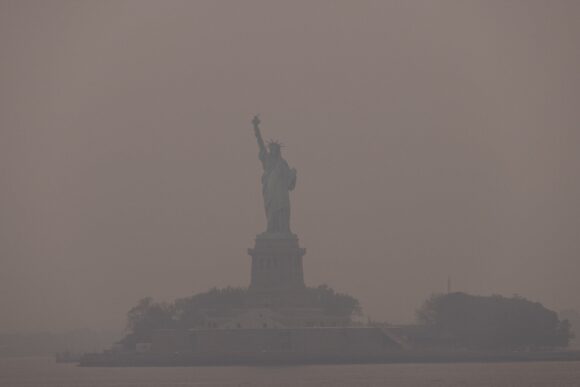
Photo credit: Victor J. Blue/Bloomberg
The worst fire season on record in Canada made global headlines last year when smoke from the blazes blotted out the skies above New York and other US cities, spawned a rare pyro-tornado and forced the evacuations of an estimated 232,000 people. The fires burned an area that was more than seven times the historic average — or about 4% of the country’s forests, according to a new study.
The flames caused more than C$1 billion ($740 million) in insured damages, according to the insurance bureau. They also may have released emissions that are more than twice the annual carbon output of the nation’s economy, a top government scientist has estimated.
This year, with 71% of Canada abnormally dry or in drought in February and swathes of the country as much as 5C (9F) warmer than normal, governments and companies are bracing for a repeat. Alberta declared a start to its wildfire season on Feb. 20 — the earliest in recent years — and a spokesman for Quebec’s forest-protection agency said the province’s season is poised to start as much as four weeks earlier than usual.
Nationally, the federal government has invested C$170 million in a satellite mission to monitor fires, while the armed forces are training more soldiers as support firefighters.
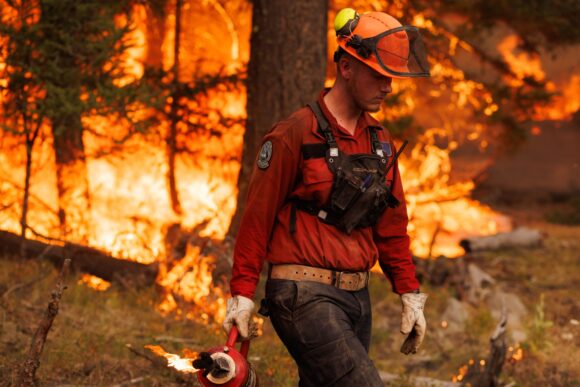
British Columbia’s provincial government created a permanent Ministry of Emergency Management and Climate Readiness in 2022 — the year after the town of Lytton burned to the ground in a record-breaking heatwave — to deal with the onslaught of fires and floods. That replaces the previous approach, where resources were mobilized temporarily in response to events. “I exist in a state of anxiety on behalf of the province,” the department’s minister, Bowinn Ma, said in a phone interview. “It has become apparent that that kind of response-focused model just wasn’t sufficient.”
The province is upgrading firefighting equipment, working to get more access to aircraft, testing night-vision technology to extend fire suppression into the hours of darkness and looking at how to use artificial intelligence to predict fires.
The province’s wildfire service also is shifting to operating year-round — rather than seasonally — and has increased its full-time staff more than 50% since 2022. British Columbia plans to almost triple the number of prescribed and cultural forest burns to pre-empt and curb wildfires this year: 61 are planned.
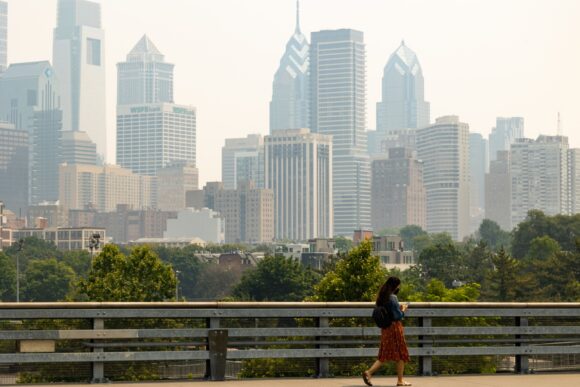
The changing weather patterns are affecting how businesses operate, too. Telecom company Telus Corp. has ramped up clearing brush around its “million-dollar” cell towers in areas at risk of fires, so communities don’t get cut off, said Phil Moore, vice president of real estate and business continuity.
The wireless provider has invested more than C$100 million in protecting infrastructure over the last five years, he said, and it’s helping fund a German startup called Dryad Networks GmbH, which uses sensors to detect wildfires earlier.
Perhaps no industry has been more affected by fires in the past decade than Canada’s oil and gas sector, which was forced to shut down more than 1 million barrels of daily output during a devastating blaze in 2016. The fire razed sections of Fort McMurray — the largest city near most producers’ oil-sands operations — and caused about C$3.7 billion in insured losses, making it Canada’s costliest natural disaster.
During last year’s fire season, energy producers including Chevron Corp., Canadian Natural Resources Ltd. and Baytex Energy Corp. at times shut production equivalent to about 300,000 barrels of oil a day as blazes encroached on wells and processing infrastructure.
The drought conditions that are spawning the fires can also hurt producers by cutting off the water they need for operating oil-sands mines and wells.
The Alberta Energy Regulator in December warned energy companies to “plan accordingly” when applying for licenses to divert water from rivers and to prepare contingency plans. Average monthly precipitation from October to the end of February was the lowest in at least 10 years in five of Alberta’s production areas, including near Lac La Biche, Fort McMurray, Slave Lake, Peace River and Grande Prairie.
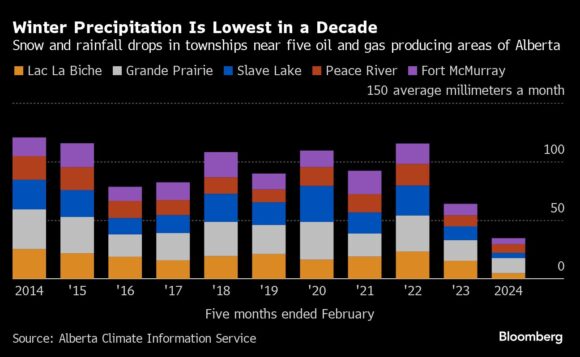
The issue is front of mind for investors. Analysts asking executives from Suncor Energy Inc., Imperial Oil Ltd. and Canadian Natural about their preparations for the drought conditions on their recent earnings calls. “We’re going to continue to have to manage that carefully,” Imperial Chief Executive Officer Brad Corson said last month of the risks to water supply.
There’s one consolation: 2023’s fires scorched such large swathes of forest that in some places, smaller fires won’t be able to merge with each other to create massive contiguous blazes, said Thomas Smith, an associate professor of environmental geography at the London School of Economics.
“The connectivity is certainly going to slow down and stop the spread of some of these fires,” Smith said. “But I don’t expect it it to be a very quiet fire year.”
Top photograph: A resident sprays water on hot spots near a house during a wildfire in Celista, British Columbia, Canada, on Saturday, Aug. 19, 2023. Photo credit: Cole Burston/Bloomberg
Topics Canada
Was this article valuable?
Here are more articles you may enjoy.


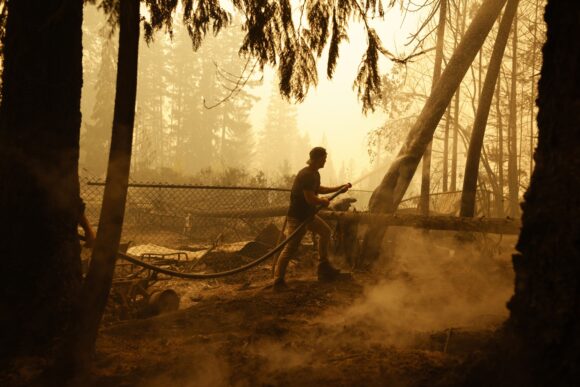
 Supreme Court Rejects Challenge to $2.46B Boy Scouts Sex Abuse Settlement
Supreme Court Rejects Challenge to $2.46B Boy Scouts Sex Abuse Settlement  Wildfires, Storms Fuel 2025 Insured Losses of $108 Billion: Munich Re Report
Wildfires, Storms Fuel 2025 Insured Losses of $108 Billion: Munich Re Report  10 Highest Class-Action Settlements in 2025 Eclipsed $70B Total: Duane Morris
10 Highest Class-Action Settlements in 2025 Eclipsed $70B Total: Duane Morris  New York Governor Hochul Vows to Tackle Insurance Affordability, Litigation and Fraud
New York Governor Hochul Vows to Tackle Insurance Affordability, Litigation and Fraud 

